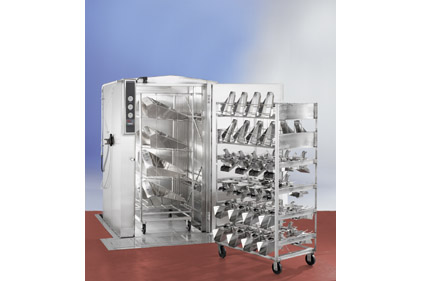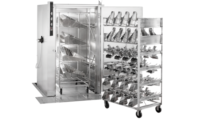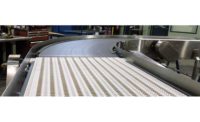Food safety continues to be a top priority for bakers and snack manufacturers. No company wants to sell tainted products to consumers, issue recalls, potentially damage its brand or be penalized by the FDA. Implementing stringent sanitation procedures—equipment, facility and employee—and investing in the right tools are essential for preventing food-safety problems and meeting new Food Safety Modernization Act (FSMA) guidelines.
A proper cleaning
When it comes to food-processing equipment, today’s equipment manufacturers are constantly looking for ways to make their machines easier to clean and maintain. High-grade materials, easily accessible parts, seamless construction and numerous other design features help facilitate cleaning and foster food safety, but they’re only part of the equipment sanitation equation. Food-processing equipment still has to be cleaned properly.
“Dry steam is absolutely ideal for commercial baking operations,” says Werner Diercks, CEO, AmeriVap Systems Inc., Dawsonville, GA. “Dry steam uses only water—no harmful or expensive chemicals. Also, since it uses literally a tiny fraction of the water of conventional methods, it’s perfectly suited for dry environments, where moisture and water are the enemy.”
Using dry steam to clean and sanitize equipment enables bakers to also achieve the “elusive goal of properly cleaning, while at the same time successfully addressing sustainability targets,” Diercks adds. Also, using dry steam eliminates the need for FSMA-mandated material safety data sheet administration, he notes. His company recently introduced two products suited to baking and snack facilities, one entry-level, economy unit suitable for small operations and one that not only provides steam, but also injects a sanitizing solution and vacuums using a proprietary mechanism.
While relatively waterless cleaning may be the best option for some equipment and operations, many cleaning processes still rely on water.
Kevin Lemen, vice president, sales and marketing, Douglas Machines Corp., Clearwater, FL, notes that his company’s washers were “developed in cooperation with manufacturers of multihead weighers. These batch washers are designed to quickly and efficiently clean scale parts, such as weigh and feed buckets, chutes, funnels, feed pans and other detachable items.”
Introduced in 2004, the machines have gone through several evolutions, with improvements to their sanitary design, wash racks, controls, jetting and filtration, and the addition of optional data loggers. “They save labor, water and energy, while helping companies achieve consistent cleaning standards and compliance with several food-safety regulations,” says Lemen. “Operation can be tracked with data loggers to monitor cycle times, wash and rinse temperatures and pressures. With wash/rinse/sanitize cycle times as short as five minutes, turnaround time for cleaning parts is quick and convenient.”
Whether they use wet or dry sanitation to clean their equipment, “food manufacturers can improve their procedures by understanding hygienic zone requirements and specifying the required equipment for the zones,” says Steve Blackowiak, food safety manager, Bühler Aeroglide, Cary, NC. “Not understanding hygienic requirements can result in over- or underspecifying equipment, such as using wet wash equipment in a dry clean zone.”
An ounce of prevention
Products that help food-processing equipment stay cleaner from the onset can also help bakers and snack manufactures more easily achieve their sanitation goals. Food-safe lubricants are one example.
According to Adam Bzowski, business development and sales manager, Chain Guard Industrial Lubricants, Markham, Ontario, industrial bakery oven chains are often lubricated with a graphite lubricant. “Although this type of lubricant has good lubricating properties,” he says, “it is not food-grade and can cause cleaning and reliability issues for sanitation and maintenance departments.”
Sanitation issues related to graphite lubricants typically revolve around the mess they can cause during application. “The natural black graphite lubricants splatter when being applied and can cause severe buildup of sludge,” Bzowski explains. “In addition, when graphite lubricant is heated during an operation, it turns to a carbon powder, which can become airborne and end up in the product consumers eat. This powder is a sanitation and maintenance issue, as it is difficult to clean and causes burners to ground during operation, resulting in decreased ribbon burner flame rectification and oven reliability and efficiencies.” He adds that graphite lubricants also contain toxic chemicals and carcinogens that can be hazardous to sanitation and maintenance department personnel.
Bzowski notes that his company offers two food-grade, synthetic, oven chain lubricants that are NSF H1 listed and suitable for bakery oven chains, with one suitable for applications up to 600°F and another, a food-grade graphite version, is suitable for extremely high temperatures, where extended lubrication is required in applications up to 1000°F. Both products contain no odors, carcinogens or toxic fumes, have no splatter or mess issues, have reduced buildup, and require minimal cleaning and maintenance.
Blackowiak notes that his company rethought the manufacturing and assembly of its dryers to improve sanitation without increasing production costs. The company used a modular technique and design with easy-to-maintain components to develop a new dryer for sugar-coated cereal and other coated products that require similar moisture removal.
“We knew drying technology for sugar-coated products, like breakfast cereals, can be time-consuming to thoroughly clean,” he explains. “We also knew hygienic challenges stem from improperly designed or manufactured equipment. To minimize contamination and bacterial growth, a cereal processor often needs eight to 14 hours to thoroughly clean a dryer that processes sugar-coated cereals. We reconsidered every aspect of the dryer operation.” In the end, the company was able to establish a typical cleaning time of two hours, a 75 percent reduction that saves processors valuable time. “The uptime between cleaning intervals also became longer. With a standard dryer, average cleaning time might be every eight hours,” he says. With the new dryer, processors can extend that timeframe to every 20 hours.
Hygienic design innovations include pitched floors and roofs, an integrated clean-in-place (CIP) system, a continuous belt washing system, a comprehensive water management system and numerous other design improvements.
Keeping contaminants out
An effective sanitation program involves more than cleaning and maintaining equipment. It also focuses on keeping contaminants out of production areas by requiring workers to follow mandatory hygiene practices, such as putting on uniforms and headwear, washing their hands and cleaning their shoes before entering.
“In any situation, sanitation and hygiene practices never go out of style,” says April Zeman, national account manager, Best Sanitizers Inc., Penn Valley, CA. “Preventing recalls, which can tarnish a product’s brand, allows producers to focus on meeting the new demands of the industry.”
Last fall, the company added a HACCP footwear-sanitizing system to its line, which, according to Zeman, “adds an additional layer of pathogen protection by reducing cross-contamination from footwear soles before employees enter the production area or other critical control zones.” The foot-operated unit, which doesn’t require power, uses compressed air to deliver a finely atomized mist of a ready-to-use, no-rinse sanitizer to the bottom of employees’ footwear.
Compared to a footbath, which needs constant monitoring, testing and record-keeping, this system, notes Zeman, provides a fresh application of surface sanitizer with each use, “eliminating the need to evaluate and document the testing of chemicals used in footbaths throughout the day.” She adds that it also eliminates the cost and time associated with disposing of footbath chemicals.
When it comes to equipment, facility and employee sanitation, bakers and snack manufacturers have numerous tools from which to choose. Selecting those that best meet their needs and operations will help them achieve their goals, meet federal regulations and protect their brands.





